Irish Morning |
|||||||
 |
 |
||||||
Knitted oversized jacket in DROPS Kid-Silk. Piece is knitted top down in stockinette stitch with European shoulder / diagonal shoulder, stripes, V-neck and I-Cord. Size XS – XXL.
DROPS 249-14 |
|||||||
|
---------------------------------------------------------- EXPLANATION FOR THE PATTERN: ---------------------------------------------------------- GARTER STITCH (back and forth): Knit all rows. 1 ridge vertically = knit 2 rows. INCREASE TIP-1 (from right side): Increase towards the left: Use left needle to pick up yarn between 2 stitches from row below, pick up yarn from the front and knit stitch in back loop of stitch. Increase towards the right: Use left needle to pick up yarn between 2 stitches from row below, pick up yarn from the back and knit stitch in front loop of stitch. INCREASE TIP-2 (from wrong side): Increase towards the left: Use left needle to pick up yarn between 2 stitches from row below, pick up yarn from the back and purl stitch in front loop of stitch. Increase towards the right: Use left needle to pick up yarn between 2 stitches from row below, pick up yarn from the front and purl stitch in back loop of stitch. LEFT BAND WITH I-CORD: RIGHT SIDE: Slip 1 stitch purlwise with strand in front of piece, knit 1 and work 5 stitches in garter stitch. WRONG SIDE: 5 stitches in garter stitch, slip 1 stitch purlwise with strand in front of piece, knit 1. RIGHT BAND WITH I-CORD: RIGHT SIDE: Work 5 stitches in garter stitch, slip 1 stitch purlwise with strand in front of piece, knit 1. WRONG SIDE: Slip 1 stitch purlwise with strand in front of piece, knit 1, work 5 stitches in garter stitch. STRIPES: Then work stripes as follows: 16-20-20-24-26-30 rows on back piece / 14-16-16-18-22-24 rows on front pieces / 12 rows on sleeves with 4 strands color off white. 2 rows with 3 strands color off white + 1 strand color soft mint 4 rows with 3 strands color soft mint + 1 strand color off white 2 rows with 2 strands color off white + 2 strands color soft mint 2 rows with 1 strand color off white + 2 strands color soft mint + 1 strand color sage green 4 rows with 4 strands color soft mint 2 rows with 1 strand color pistachio ice cream + 2 strands color soft mint + 1 strand color off white 6 rows with 2 strands color pistachio ice cream + 2 strands color soft mint 2 rows with 1 strand color soft mint + 3 strands color pistachio ice cream 6 rows with 4 strands color pistachio ice cream 4 rows with 2 strands color off white + 2 strands color pistachio ice cream 2 rows with 3 strands color pistachio ice cream + 1 strand color sage green 4 rows with 1 color sage green + 1 strand color off white + 1 strand color pistachio ice cream + 1 strand color soft mint 6 rows with 3 strands color off white + 1 strand color sage green 2 rows with 2 strands color sage green + 1 strand color off white + 1 strand color soft mint 4 rows with 1 strand color sage green + 1 strand color off white + 1 strand color pistachio ice cream + 1 strand color soft mint 4 rows with 2 strands color sage green + 1 strand color off white + 1 strand color pistachio ice cream 4 rows with 2 strands color sage green + 2 strands color pistachio ice cream 4 rows with 3 strands color sage green + 1 strand color pistachio ice cream Work until finished measurements with 4 strands color sage green BUTTONHOLES: Decrease for buttonholes on right band (when garment is worn). Decrease from right side when 4 stitches remain on row as follows: Make 1 yarn over, knit 2 together, slip 1 stitch purlwise with strand in front of piece, knit 1. On next row (wrong side) knit the yarn over to make a hole. Decrease for first buttonhole 1 cm = ⅜" after last increase for V-neck, then decrease for the next 3 buttonholes approx. 8½-9-9-10-9½-10 cm = 3¼"-3½"-3½"-4"-3 5/9"-4" apart. Decrease for last buttonhole in transition between stockinette stich and rib. DECREASE TIP (applies to mid under sleeves): Decrease 1 stitch on each side of marker thread as follows: Work until 3 stitches remain before marker thread and knit 2 together, knit 2 (marker thread is between these 2 stitches), slip 1 stitch knitwise, knit 1, pass slipped stitch over stitch worked. ---------------------------------------------------------- START THE PIECE HERE: ---------------------------------------------------------- JACKET - SHORT OVERVIEW OF THE PIECE: In this pattern long and short needles have been used, begin with fitting length and switch as needed. Begin by casting on stitches in the back of neck. Then work back piece downwards while at the same time increasing in each side of piece until number of stitches for shoulder width is reached. Back piece has a slight diagonal shoulder. Then work down to armholes. Now put back piece aside and work the front pieces. Begin front pieces by working a loose band then picking up stitches along one shoulder from back piece. Work downwards to armhole while at the same time increasing towards the neck. Repeat on the other shoulder. At the armholes slip front piece and back piece on to same circular needle, and work the body downwards back and forth on circular needle. Pick up stitches for sleeves around the armholes. First work back and forth with short rows to form a sleeve cap. Then work sleeves downwards in the round on needle. Sew the loose bands to cast-on edge at the back of neck. BACK PIECE: Cast on 22-22-24-24-26-26 stitches on circular needle size 7 MM = US 10.75 with 4 strands in color off white. Purl 1 row from wrong side. Then work STRIPES - read explanation above. Read INCREASE TIP-1 and work next row from right side as follows: Knit 3, increase towards the left, knit until 3 stitches remain, increase towards the right, knit 3. Read INCREASE TIP-2 and work next row from wrong side as follows: Purl 3, increase towards the left, purl until 3 stitches remain, increase towards the right, purl 3. Continue like this and increase the same way from both right side and wrong side 18-20-20-22-24-26 times in total. After last increase there are 58-62-64-68-74-78 stitches on needle. Insert 1 marker in the side. Now measure piece from here! Work stockinette stitch back and forth until piece measures 11-12-12-13-13-14 cm = 4⅜"-4¾"-4¾"-5⅛"-5⅛"-5½", measured along the edge of armhole. REMEMBER THE KNITTING GAUGE! Work next row as follows from right side: Knit 3, increase towards the left, work until 3 stitches remain, increase towards the right, knit 3 – remember INCREASE TIP-1. Increase like this on every row from right side 2-2-3-3-3-3 times in total = 62-66-70-74-80-84 stitches. Work until piece measures 14-15-16-17-17-18 cm = 5½"-6"-6¼"-6¾"-6¾"-7", measured along armhole. Back piece measures approx. 25-28-29-31-32-34 cm = 9¾"-11"-11⅜"-12¼"-12½"-13⅜" in total from cast-on edge, finish with a row from right side. Cut the yarn, slip stitches on a thread or stitch holder, and work bands and front pieces as explained below. LEFT BAND: Cast on 7 stitches on circular needle size 7 MM = US 10.75 with 4 strands in color off white. Work LEFT BAND WITH I-CORD - read explanation above. Continue until band measures 8-8-9-9-9-9 cm = 3⅛"-3⅛"-3½"-3½"-3½"-3½", finish with a row from wrong side, then continue as explained below left front piece. LEFT FRONT PIECE: Work from right side over the 7 band stitches, then pick up 18-20-20-22-24-26 stitches inside outermost stitch along left shoulder on back piece (i.e. pick up 1 stitch in every row from edge at the top of back piece, see D on chart) = 25-27-27-29-31-33 stitches. All length measurements on front piece are done from here. Work stockinette stitch with 7 band stitches towards mid front and STRIPES - remember explanation above. When piece measures 7 cm = 2¾", increase stitches towards the neck. Increase as follows from right side: Work 8 stitches, increase towards the left, work the rest of row - remember INCREASE TIP-1. Increase 1 stitch every other row 9 times in total, then on every 4th row 2-2-3-3-4-4 times in total. AT THE SAME TIME when piece measures 21-22-22-23-25-26 cm = 8¼"-8¾"-8¾"-9"-9¾"-10¼", work next row as follows from right side: 7 band stitches as before, work until 3 stitches remain, increase towards the right, knit 3 – remember INCREASE TIP-1. Increase like this on every row from right side 2-2-3-3-3-3 times in total = 38-40-42-44-47-49 stitches. Continue stockinette stitch and band stitches as before until piece measures 24-25-26-27-29-30 cm = 9½"-9¾"-10¼"-10⅝"-11⅜"-11¾", slip stitches on a thread or needle, make sure that last row worked is from right side, and to finish on same stripes as back piece. Fasten off. Then work right front piece as explained below. RIGHT BAND: Cast on 7 stitches on circular needle size 7 MM = US 10.75 with 4 strands in color off white. Work RIGHT BAND WITH I-CORD - read explanation above. Continue until band measures 9-9-10-10-11-11 cm = 3½"-3½"-4"-4"-4⅜"-4⅜", finish with a row from wrong side, then continue as explained below right front piece. Fasten off. RIGHT FRONT PIECE: Pick up 18-20-20-22-24-26 stitches with 4 strands in color off white inside outermost stitch along right shoulder on back piece (i.e. pick up 1 stitch in every row from edge at the top of back piece, see E on chart), then work the 7 band stitches on to row = 25-27-27-29-31-33 stitches. All length measurements on front piece are done from here. Work stockinette stitch with 7 band stitches towards mid front and stripes. When piece measures 7 cm = 2¾", increase stitches towards the neck. Increase as follows from right side. Work until 8 stitches remain, increase towards the right, work 8 stitches as before – remember INCREASE TIP-1. Increase 1 stitch every other row 9 times in total, then on every 4th row 2-2-3-3-4-4 times in total. Decrease for BUTTONHOLES - read explanation above. AT THE SAME TIME when piece measures 21-22-22-23-25-26 cm = 8¼"-8¾"-8¾"-9"-9¾"-10¼", work next row as follows from right side: Work 3 stitches, increase towards the left, work the rest of row - remember INCREASE TIP-1.Increase like this on every row from right side 2-2-3-3-3-3 times in total = 38-40-42-44-47-49 stitches. Continue stockinette stitch and band stitches as before until piece measures 24-25-26-27-29-30 cm = 9½"-9¾"-10¼"-10⅝"-11⅜"-11¾", make sure that last row worked is from right side, and to finish on same stripes as back piece and left front piece. Work next row as follows – from wrong side: Work over the 38-40-42-44-47-49 stitches from right front piece, cast on 4-4-6-6-8-10 new stitches at the end of this row, work from wrong side over the 62-66-70-74-80-84 stitches on back piece, cast on 4-4-6-6-8-10 new stitches, work over the 38-40-42-44-47-49 stitches from left front piece. BODY: = 146-154-166-174-190-202 stitches. Continue back and forth with stockinette stitch and stripes. Work until piece measures 49-51-53-55-57-59 cm = 19¼"-20"-21"-21⅝"-22½"-23¼", measured from where stitches were picked up for front pieces. Work 1 row from right side while increasing 22-22-22-26-26-30 stitches evenly (do not increase over bands) = 168-176-188-200-216-232 stitches. Switch to circular needle size 5 MM = US 8. Work rib as follows – from wrong side: 7 band stitches as before, * knit 2, purl 2 *, repeat from *-* until 9 stitches remain, purl 2 and 7 band stitches as before. Continue rib like this for 6 cm = 2⅜". Bind off. Jacket measures approx. 55-57-59-61-63-65 cm = 21⅝"-22½"-23¼"-24"-24¾"-25½", measured from the top point on shoulder. SLEEVES: Place piece flat and insert 1 marker at the top of armhole (NOTE! It is not where stitches were picked up for front piece but approx. 5-6 cm = 2"-2⅜" down on front piece = mid on top of shoulder). Use circular needle size 7 MM = US 10.75 and 4 strands in color off white and work STRIPES - remember explanation above, begin in the middle of the new stitches cast on under sleeve, and pick up 56-58-62-66-70-74 stitches around the armhole - adjust to pick up same number of stitches on each side of marker along armhole. Now work stockinette stitch back and forth with short rows over sleeve cap, this is done to get a better shape on sleeve. Begin mid under sleeve. 1st row (right side): work 7-7-7-8-8-9 stitches past marker, turn 2nd row (wrong side): work 7-7-7-8-8-9 stitches past marker, turn. 3rd row (right side): 6-6-5-5-4-4 stitches past where the previous turn was, turn 4th row (wrong side): work 6-6-5-5-4-4 stitches past where the previous turn was, turn Repeat 3rd and 4th row until 25-25-27-28-28-29 stitches have been worked past marker mid on top of sleeve (4-4-5-5-6-6 turn have been done in each side). Work from right side until beginning of round (mid under sleeve). Insert 1 marker thread here, this is used when decreasing stitches under sleeve. Move marker thread upwards when working. Continue working in the round in stockinette stitch over all stitches. When sleeve measures 7-7-8-8-9-10 cm = 2¾"-2¾"-3⅛"-3⅛"-3½"-4" from where stitches were picked up (all length measurements are done mid on top of sleeve), decrease 2 stitches mid under sleeve - read DECREASE TIP. Decrease every other round 2-2-3-3-4-4 times, then decrease every 4½-4-4-3-2½-2-1½ cm = 1⅝"-1½"-1½"-1⅛"-1"-¾"-½" 8-8-8-10-10-11 times, 10-11-11-13-14-15 times in total = 36-38-40-40-42-44 stitches. Continue to work until sleeve measures 46-45-46-45-44-43 cm = 18"-17¾"-18"-17¾"-17¼"-17". 6 cm = 2⅜" remain until finished measurements. Try the jacket and work to desired length before rib. Knit 1 round while increasing 8-6-8-8-10-8 stitches evenly = 44-44-48-48-52-52 stitches. Switch to double pointed needles size 5.5 MM = US 9. Work rib (knit 2/purl 2) for 6 cm = 2⅜". Bind off. Sleeve measures approx. 52-51-52-51-50-49 cm = 20½"-20"-20½"-20"-19¾"-19¼". ASSEMBLY: Sew buttons on to left front piece. Sew the loose bands together mid back, and sew on to cast-on edge at the back of neck. |
|||||||
Diagram explanations |
|||||||
|
|||||||

|
|||||||

|
|||||||
|
Have you made this or any other of our designs? Tag your pictures in social media with #dropsdesign so we can see them! Do you need help with this pattern?You'll find tutorial videos, a Comments/Questions area and more by visiting the pattern on garnstudio.com. © 1982-2024 DROPS Design A/S. We reserve all rights. This document, including all its sub-sections, has copyrights. Read more about what you can do with our patterns at the bottom of each pattern on our site. |
|||||||







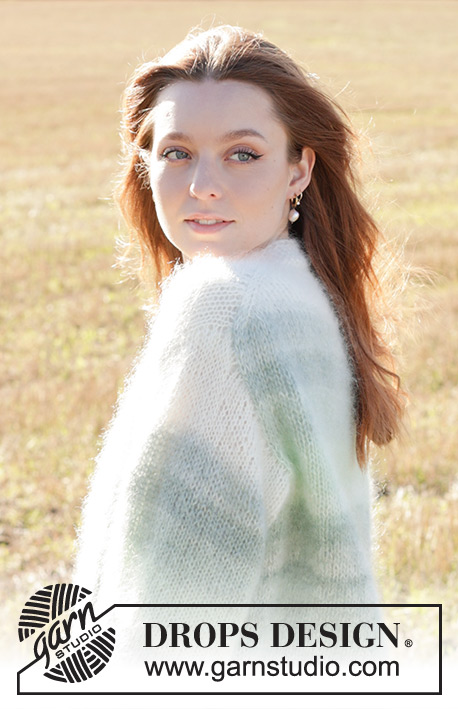

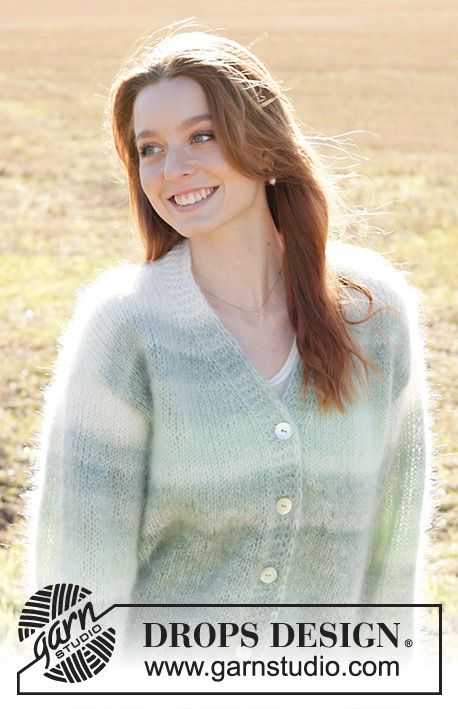

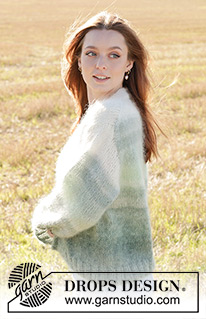
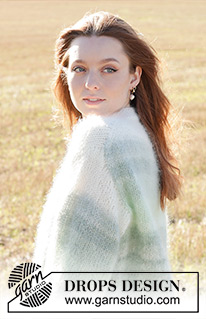
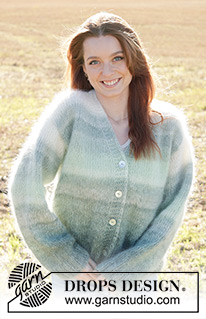






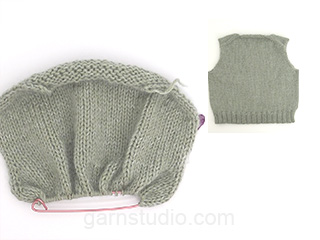
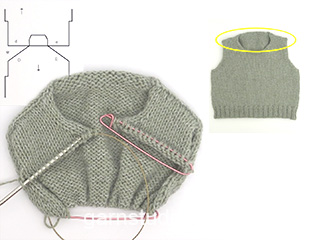
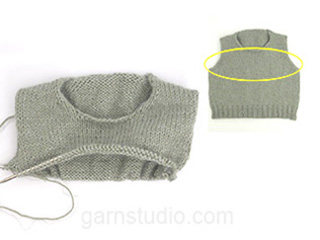
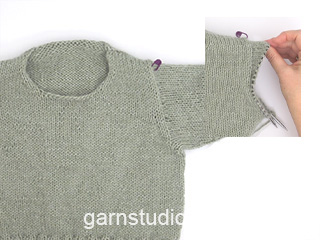
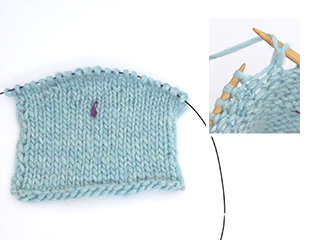


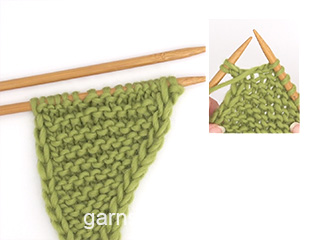
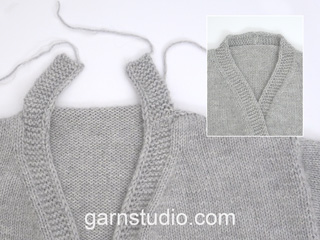




























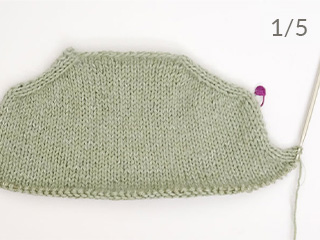
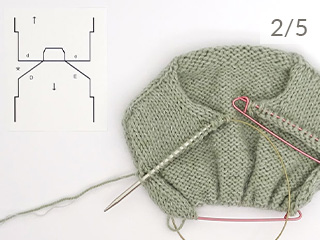
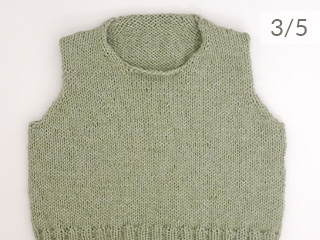























Comments / Questions (12)
Bonjour ! Les explications disent que tout le modèle se tricote en point mousse, mais sur la photo le gilet semble être tricoté en jersey (dans l'explication en anglais aussi il est mentionné "garter stitch"). Je voudrais m'assurer qu'il s'agit bien ou non d'un jersey avant de me lancer 🙌
04.04.2024 - 22:13DROPS Design answered:
Bonjour Charline, le gilet se tricote effectivement en jersey avec la bordure des devants. au point mousse (raison pour laquelle il est expliqué au début comment tricoter du point mousse). Bon tricot!
05.04.2024 - 08:16Cardigan bosque
22.01.2024 - 00:29Morning grass
20.01.2024 - 08:09Pine Breezes
20.01.2024 - 04:39Emerald Lines Cardigan
19.01.2024 - 15:09Spring Forest
19.01.2024 - 13:31Cloudberry dreams
18.01.2024 - 23:45Verdant Horizons
18.01.2024 - 23:44Arc en ciel
18.01.2024 - 20:22Printemps
18.01.2024 - 16:19